Last Updated on December 30, 2022
Are you having trouble with unwanted algae in your betta tank?
A little green or brown algae buildup on rocks and driftwood isn’t necessarily a bad thing, but extreme levels of growth can make your aquarium look unappealing.
Fortunately, there are solutions to help keep your betta tanks looking beautiful and clean.
Algae growth is a natural occurrence in any fish habitat, but you can limit the level of growth by following good tank maintenance habits.
So don’t give up your beautiful hobby; follow these steps to ensure your tank is free from algae infestation.
Let’s dive into it!
Table of Contents
TL;DR
- Algae in small quantities aren’t bad for your tank. It can serve as food for your betta fish and other species.
- Some algae are green, black beard, blue-green, staghorn, and brown algae.
- Too much light, excess phosphate and nitrate -, and poor water parameters are the common causes of algae buildup.
- Adding live plants, filters, and an algae eater to your tank can minimize algae production.
Is Algae Bad for Betta Fish?
It may sound strange, but having a bit of green algae growth in your betta tank can actually be beneficial!

Not only does it indicate a balanced ecosystem, but it’s also a great source of food for fish like algae eaters and even betta fish and helps to remove toxins from the water.
The key is keeping algae under control. If there are too much algae in your tank, it can interfere with live plants’ growth and oxygen levels.
Also, remember that not all algae types are suitable for your betta tank.
Types of Algae in Betta Tank
Common Brown Algae
Brown spot algae, also known as diatoms (Bacillariophyceae), are a common sight in aquariums.
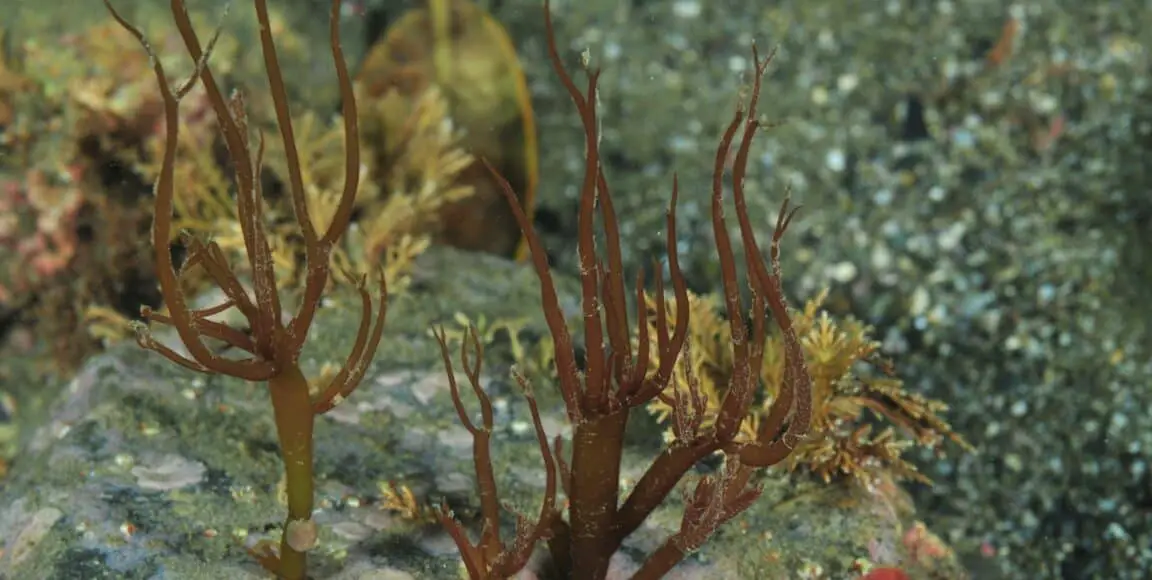
These slimy and soft brown algae can grow on decorations, plants, and even glass surfaces in dark tanks.
The fluctuation of water parameters often encourages their growth, though they can be easily removed with a quick wipe.
Common Green algae
Common green algae can be found in aquariums and manifest themselves in various forms.
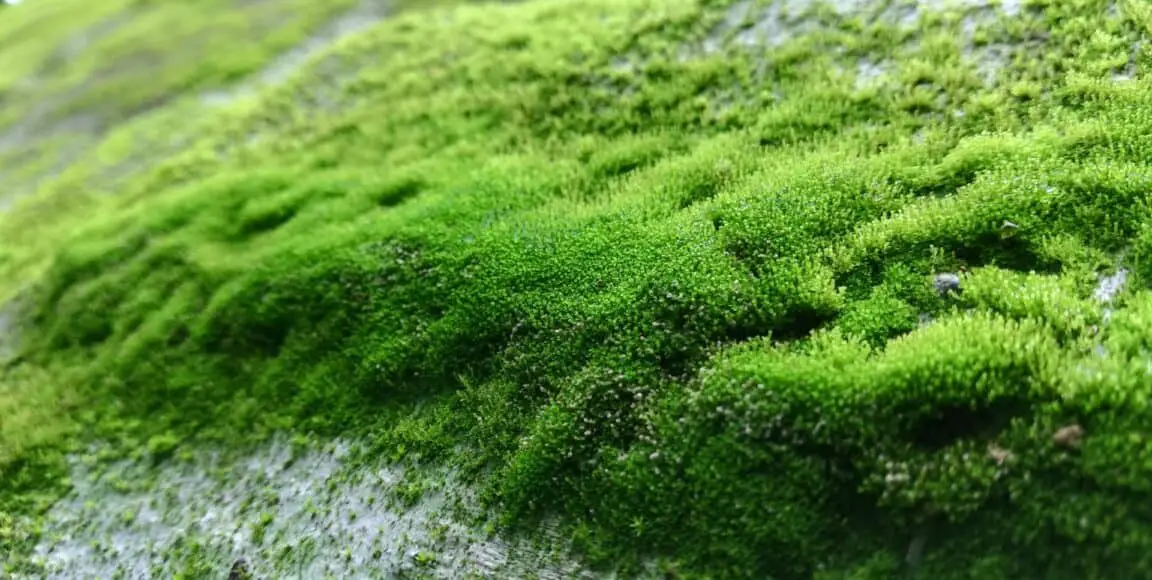
Green spot algae, usually of the Coleochaete family, are hard to remove as they coat glass, live plants, and decorations. You’ll need to physically scrape them off.
Green dust algae is a mild form of green algae which usually coats the glass and substrate but doesn’t form filaments.
On the other hand, Chlorella will turn all water in your aquarium bright green and opaque as it free-floats around.
Lastly, green hair algae, also known as Oedogonium, can be in different shapes, such as strands, networks of stems, or hairy appearance.
This type of algae is easy to remove with a toothbrush but can return just as quickly. Algae eaters usually don’t find it attractive due to its long filaments.
Black beard algae (BBA) / Brush algae
Black beard algae (BBA) or brush algae (Audouinella sp., Rhodochorton sp.) belong to the group of red algae.
Like staghorn algae, their natural color is not red but varies from dark green over gray to deep black. However, if you put these in alcohol, they will turn reddish.
These cling stubbornly to the ground they grow on, like technical equipment, the leaf margins of aquatic plants, aquarium decoration, or even grains of the substrate. T
These will grow on the leaf edges of your plants that are the slowest growing.
They develop in clumps or patches varying from black to red. Shoot tufts that are dark brown or black, difficult to remove manually.
Blue-Green Algae
They are technically not algae but cyanobacteria (blue bacteria). But you can treat them the same way with algae.
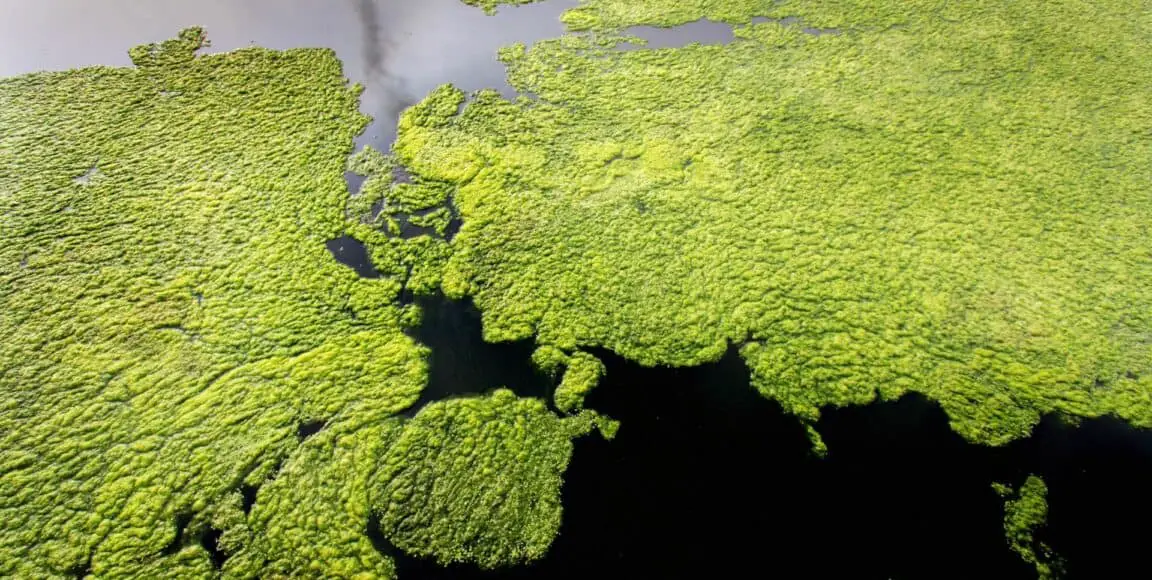
They are a slimy type of mossy substance that can quickly overtake the substrate, especially where the glass meets the gravel.
It forms “mats” on the surface of plants and substrate. Most commonly dark emerald green, but it can also be red or brown. It also has a distinct smell to them.
Staghorn Algae
Staghorn algae (Compsopogon sp.) belong to the group of red algae. They are easy to diagnose as their growth habit looks like the horns of a stag.
We usually find staghorn algae on aquarium decorations, technical equipment, and the margins of the leaves of aquatic plants. They are hard to remove manually and seem unattractive for most algae-eating aquarium animals.
Reasons Why Algae Appears in Your Tank
#1 – Excess phosphate and nitrate buildup.
Overfeeding increases these substances.
In a planted aquarium, healthy plants consume and remove these nutrients from the water. It is a symptom of a nutrient imbalance or buildup in your tank.
#2 – Too much light exposure
Light is the number one source of energy for algae. Without light, it will not grow. However, light is also important for your betta fish and plants.
It’s best to monitor and time photoperiods to keep the algae from developing.
#3 – Poor water parameters
Lack of maintenance also contributes to the appearance of algae.
Most nutritional imbalances cause increased algal growth. Our slacking tank maintenance, such as if we skip regular water changes, contributes to this.
A weekly water change of around 20-50% is vital for the overall development of an aquarium, and it may prevent algae.
Changing the water also helps remove unwanted substances and prevent certain elements from building up in the water.
How to Minimize Algae Build-Up in Betta Tanks
As they say, prevention is better than cure. If you want to minimize the likelihood of having unwanted algae in your betta tank, there are some easy steps you can follow:
Add an algae-eating tank mate
Some good algae eaters include shrimp species like Cherry and Ghost shrimp, snail species like Malaysian Trumpet snails, Guppies, Siamese algae eaters, Chinese algae eaters, and Otocinclus Catfish.

These algae eaters will not only help reduce algae but can also be great additions to the overall ecosystem of your tank.
When choosing the best algae eater for your tank, you should consider your tank size and the minimum number of algae eaters you need to clean the tank adequately.
Remove the tank from direct sunlight
Sunlight can contribute to algae buildup and can harm your betta fish as well.
Uncontrolled water temperature changes due to direct sunlight can create an unhealthy environment for your betta fish.
So avoid putting your tank near the window or in any place that gets a lot of sunlight.
Add quality filter
Having the right filter is a crucial part of keeping your aquarium free from algae.
A proper filter that cycles through the water efficiently helps reduce ammonia, nitrites, and nitrates, all of which can support algae growth.
Add live plants
Live plants are one of the best natural ways to keep your aquarium algae-free. Not only do they help remove excess nitrates (an important factor in controlling algae), but they also add beauty and vibrancy to your tank.
For beginners, choosing a suitable plant can be intimidating.
But don’t worry – there are several beginner-friendly plants that won’t require too much attention, like Java Moss, Anubias Nanas, and Java Fern.
Use socket timers
We all know how important lighting is for your aquarium, but leaving it on too long can result in algae growth.
Using a socket timer to regulate the lighting schedule is essential – this will help ensure that you only turn on the lights when necessary and for the right amount of time.
This will reduce unwanted light exposure and create an ideal environment for your betta fish.
Different Ways How To Keep Algae Out Of Betta Tank
If you can’t minimize algae growth in your betta tank even after following the tips above, your next resort is to clean it correctly.
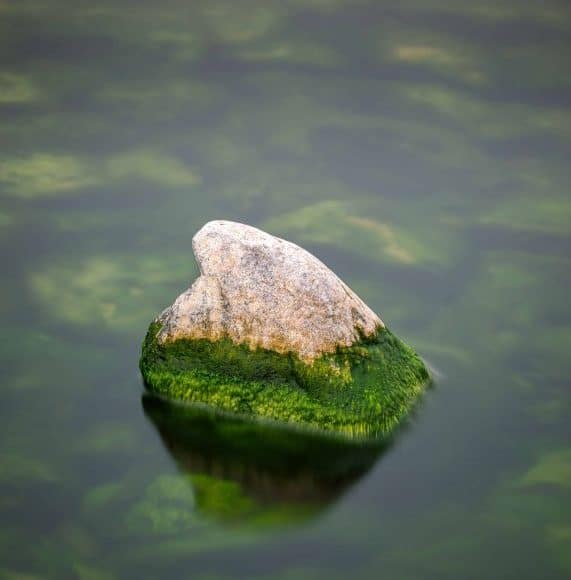
Scraping
We can use razor blades to scrape the glass. Here are a few online products to help you with your glass scraping needs.
Best algae scrapers
SLSON Double Sided Sponge Brush Cleaner
- HIGH QUALITY BRUSH:the aquarium brush made of high quality sponge,it could remove the alge quickly and effectively,keep your fish tank inhabitants a clean environment.
- NON SLIP HANDLE: the brush handle made of premium plastic,sturdy and durable,wiht non slip handle surface,make this clean work more easily.
- EASY TO STORE:designed with a hole on the end of the handle,more convenient for you to hanging and store,keep the brush head dry and use for long time.
- CONVENIENT USED:this algae scraper brush suitable for glass fish tank, a great assistant tool for your aquariums. BUT not sutiable for Acrylic fish tank, and plastic fish tank.
- PLEASE NOTE:please rinse the brush pad with tap water before and after each use, keep the brush head clean and dry before store.
Prices pulled from the Amazon Product Advertising API on:
Product prices and availability are accurate as of the date/time indicated and are subject to change. Any price and availability information displayed on [relevant Amazon Site(s), as applicable] at the time of purchase will apply to the purchase of this product.
Aquarium algae brush made of high-quality sponge which could make algae removal quick and effective. Brush handle made of premium plastic, sturdy and durable. Has a non-slip handle surface. Suitable only for glass fish tanks. It is not suitable for plastic and acrylic fish tanks. Designed with a hole at the end of the handle for convenient hanging and storage. Rinse with fresh clean water before and after use.
SLSON Stainless Steel Scraper Cleaner
These scraper blades have a unique right-angle design which could remove buildup completely with no residue. Can clean the tank corners and avoid scratching of glass surfaces.
The scraper material is high-quality stainless steel which makes it strong and durable. The surface is resistant to rust or corrosion. It comes with 10 pieces of right-angle blades.
The cleaner comes in with two bonus handles approximately 25 inches in length. This product is only suitable for glass aquariums. It will scratch tanks made of acrylic.
Do not use it on dry surfaces. Rinse pad with tap water before and after each use. Do not use it in high concentration saltwater, saltwater contains chlorine, which is corrosive to metals, including stainless steel. Please keep it away from children as the blade is sharp.
Kent Marine Pro-Scraper II
- Durable construction-handles are made of corrosion resistant fiberglass
- Comes prepacked with three different blades to determine which works best for each cleaning job
- Blades are interchangeable and replaceable
Prices pulled from the Amazon Product Advertising API on:
Product prices and availability are accurate as of the date/time indicated and are subject to change. Any price and availability information displayed on [relevant Amazon Site(s), as applicable] at the time of purchase will apply to the purchase of this product.
Corrosion-resistant fiberglass makes up a durable construction-handle. An extendable cleaning tool has an easy to adjust handle length feature done with a simple twist. The Kent Marine Pro Scraper comes with three interchangeable blades; one steel, one plastic, and one green felt. They made the green felt blade for scraping algae on acrylic tank surfaces. Use the plastic blade for removing algae on acrylic surfaces with no problems. We should use the steel blade on glass surfaces only. The Pro Scraper heads and blades are interchangeable and replaceable.
Bleach
You can use bleach to clean aquarium decorations, which have extensive algae accumulation.
- Prepare a bleach soak that comprises 10% bleach in a specified amount of water.
- Soak the items for about 15 to 30 minutes.
- Scrub off as much grime as you can.
- Rinse them off very well under running water and let them out to dry before returning them to the betta tank.
Glass Cleaner
Use a safe glass cleaner when cleaning the outside of your aquarium.
Once you clean the inside of the aquarium, do the hood, light, tank top, and outside glass next. Regular glass cleaners contain ammonia, which is toxic to fish. Standard lime cleaners are even more toxic.
For better results, use vinegar or an aquarium safe cleaner, and ensure you rinse the surfaces with a clean damp cloth.
Water Siphon
You should clean the gravel/substrate of your tank when doing weekly maintenance.
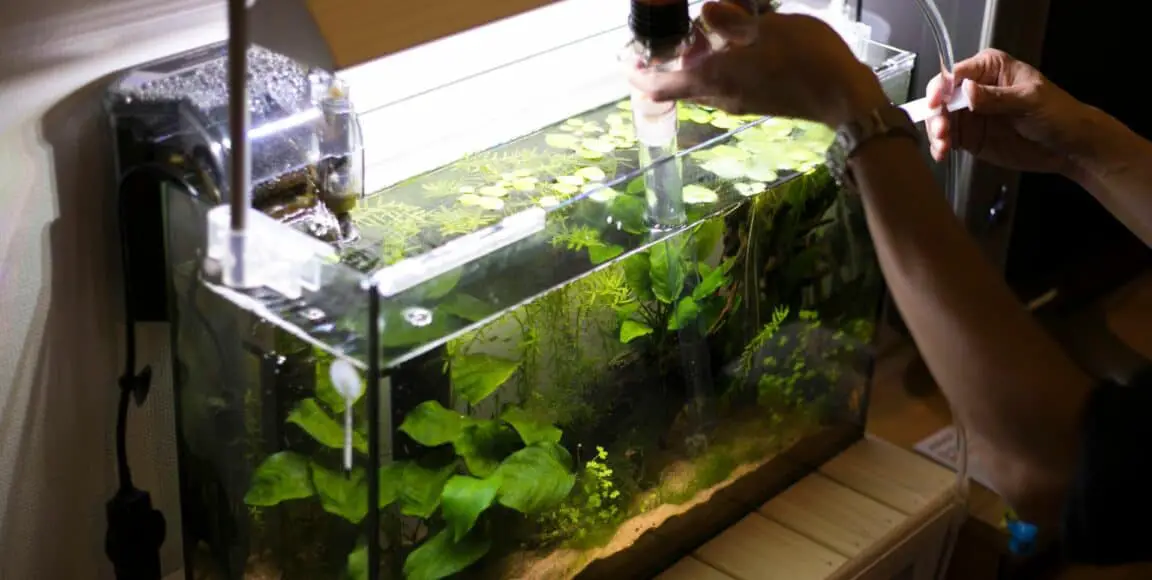
Different aquarium siphon brands are available, all of which work essentially the same. From manually operated to automated, pick the one that fits your requirements and budget.
Aquarium gravel vacuums or water siphons suck up water with the detritus from the substrate.
Use these to vacuum away debris on the substrate.
The gravel vacuum should stir up the gravel and remove debris without sucking up the gravel. Be sure to vacuum the entire gravel surface thoroughly to remove all debris.
Go through the entire substrate of the tank and siphon gravel until the water is almost clear.
Water Changes
Keeping good water parameters will be one of your best weapons against algae growth.
Regular maintenance of your betta fish tank is a must for any betta enthusiast. This is a responsibility that we should not avoid.
Water changes are significant in the battle against algae proliferation.
Do partial water change of 20-30% weekly. Replace it with clean, fresh water treated with a water conditioner. It’s not a good idea to take more water out because this may alter the water parameters of your betta tank.
Water changes will prevent the buildup of too many harmful substances, such as ammonia, nitrite, and nitrate. This will also replenish the minerals needed by your betta fish.
Filter Maintenance
Keep your filter media in excellent condition by cleaning it once a month. Filter media contains beneficial bacteria responsible for keeping the nitrogen cycle established in your tank.
In addition, rinse out debris using tank water. Squeeze out sponges in a bucket with tank water until the water coming from the sponges are more or less clear. Do not use tap water to clean your filter.
Light Control
Too much light can significantly contribute to the growth of algae. So, only switch on the lights for six hours in the beginning.
When the biological system in the tank runs stable, and without problems, you may increase the daily lighting time by half an hour per week.
Under moderate to intense light, aim for a daily lighting time of 8 to 10 hours; a longer phase of 10 to 12 hours is recommendable under less powerful light.
Some fish keepers perform a complete tank blackout for around four days. Turn off all lights and wrap the tank in something dark so light can’t get in. Do this to starve the algae of light.
Algaecides
Algaecides are chemicals that suffocate or destroy the algae present in your tank.
This should only be a last resort. We cannot perform it too many times because it will destroy the beneficial bacteria established in your fish tank. This will cause the tank to re-cycle.
These come in different types, like liquids, powders, or tablets.
The major drawback is that algaecide can destroy plants and kill invertebrates. It is a quick solution but not a permanent one.
UV Sterilizers
A UV sterilizer penetrates and breaks down the algae cell wall, allowing them to adhere to each other.
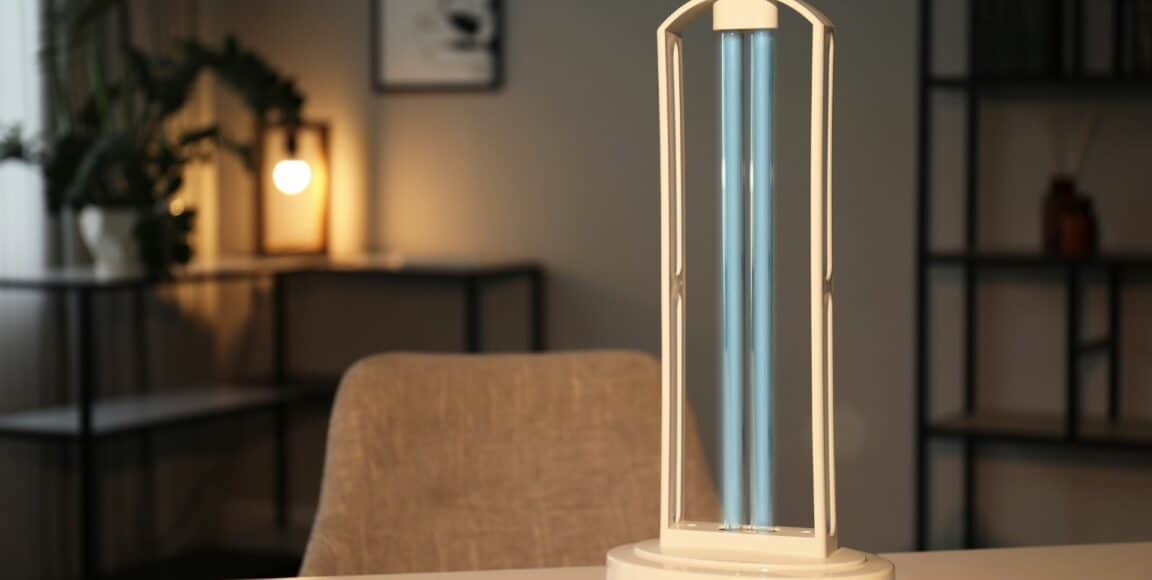
This causes the algae to flocculate or clump together, enabling the filter to remove it from the water. It also helps diminish and keep away the unwanted green algae from your water.
High-intensity UV light sterilizes the bacteria and microorganisms present in the water by breaking their cell membranes or damaging their DNA or other organelles in the cells.
Ultraviolet sterilizers can help reduce the spread of free-floating algae. While it will kill algal blooms, it will not eradicate them.
A UV sterilizer is not a replacement for a good biological and mechanical filter, which is still necessary to filter out algae from the water.
FAQs
Will algae go away in its own aquarium?
Yes, it can. But only if it doesn’t get enough light or nutrients from the water. Most of the time, it will take a few water changes and proper tank management to get rid of algae.
Is it bad to have algae in a tank?
It depends. Not all the algae are harmful to your betta fish. Some algae, like green algae, can benefit your tank and fish. But too much of it can be detrimental as it will take away oxygen and nutrients from the water.
How do I get rid of algae in my betta tank?
There are different ways to get rid of algae in a betta tank. You can use water changes, filter maintenance, light control, algaecides, and UV sterilizers. You can also add the best algae eaters, like shrimps, snails, a Siamese algae eater, or a Chinese algae eater.
Conclusion
Algae is one of those things that all fish owners must deal with at some point—but there are ways you can drastically reduce its chances of appearing in your betta tank.
By reducing light exposure, maintaining water quality levels, and regularly cleaning your tank, you’ll be well toward having an algae-free environment for your betta fish.
With these tips in mind, you’ll soon have a healthy and beautiful betta tank!


